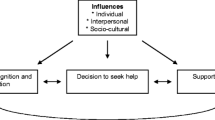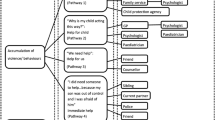Abstract
The purpose of this study was to determine motivators for intimate partner violence (IPV) help-seeking among mothers. This qualitative study used English and Spanish-speaking focus groups and a grounded theory approach. Sixty-two mothers participated in eight groups. Motivators for IPV help-seeking fell into two broad categories, internal and external motivators. Although participants cited numerous motivators for IPV help-seeking, recognizing the negative effects of IPV on their children, labeling the partner’s behavior as abusive and the intervention of others were particularly important. For many participants, the effects of IPV on their children were the most important motivator. Few women made the decision to seek help without the encouragement of others. Unique to the Spanish-speaking participants was the influence of immigration status and limitations to disclosure created by using significant others as translators. Exploration of incorporating these motivators into IPV intervention efforts is warranted.

Similar content being viewed by others
References
Antle, B. F., Barbee, A. P., Sullivan, D., Yankeelov, P., Johnson, L., & Cunningham, M. R. (2007). The relationship between domestic violence and child neglect. Brief Treatment and Crisis Intervention, 7(4), 364–382.
Appel, A. E., & Holden, G. W. (1998). The co-occurrence of spouse and physical child abuse: A review and appraisal. Journal of Family Psychology, 12(4), 578–599.
Bair-Merritt, M. H., Blackstone, M., & Feudtner, C. (2006). Physical health outcomes of childhood exposure to intimate partner violence: As systematic review. Pediatrics, 117(2), e278–e290.
Bair-Merritt, M. H., Mollen, C., Yau, P., & Fein, J. (2006). Impact of domestic violence posters on female caregivers’ opinions about domestic violence screening and disclosure in a pediatric emergency department. Pediatric Emergency Care, 22(11), 689–693.
Bair-Merritt, M. H., Jennings, J. M., Burrell, C. R., McRalane, E., & Duggan, A. K. (2010). Reducing maternal intimate partner violence after the birth of a child: A randomized controlled trial of the Hawaii Healthy Start Home Visitation Program. Archives of Pediatric and Adolescent Medicine, 164(1), 16–23.
Baldry, A. C. (2003). Bullying in schools and exposure to domestic violence. Child Abuse & Neglect, 27(7), 713–732.
Banyard, V. L. (2008). Measurement and correlates of prosocial behavior: The case of interpersonal violence. Violence and Victims, 23(1), 83–97.
Beeble, M. L., Post, L. A., Bybee, D., & Sullivan, C. M. (2008). Factors related to willingness to help survivors of intimate partner violence. Journal of Interpersonal Violence, 23(12), 1713–1729.
Cavanagh, L., Dobash, R. E., & Dobash, R. P. (2007). The murder of children by fathers in the context of child abuse. Child Abuse & Neglect, 31(7), 731–746.
Chapman, D. P., Anda, R. F., Felitti, V. J., Dube, S. R., Edwards, V. J., & Whitfield, C. L. (2004). Adverse childhood experiences and the risk of depressive disorders in adulthood. Journal of Affective Disorders, 82(2), 217–225.
Christian, C. W., Scribano, P., Seidl, T., & Pinto-Martin, J. A. (1997). Pediatric injury resulting from family violence. Pediatrics, 99(2), E8.
Darley, J. M., & Latane, B. (1968). Bystander intervention in emergencies: Diffusion of responsibility. Journal of Personality and Social Psychology, 8(4), 377–383.
Dong, M., Anda, R. F., Felitti, V. J., Dube, S. R., Williamson, D. F., Thompson, T. J., & Giles, W. H. (2004). The interrelatedness of multiple forms of childhood abuse, neglect and household dysfunction. Child Abuse & Neglect, 28(7), 771–784.
Dube, S. R., Anda, R. F., Felitti, V. J., Chapman, D. P., Williamson, D. F., & Giles, W. H. (2001). Childhood abuse, household dysfunction and the risk of suicide throughout the lifespan: Findings from the adverse childhood experiences study. Journal of the American Medical Association, 286(24), 3089–3096.
Ellis, K. K., Change, C., Bhandari, S., Ball, K., Geden, E., Everett, K. D., & Bullock, L. (2008). Rural mothers experiencing the stress of intimate partner violence or not: Their newborn health concerns. Journal of Midwifery & Women's Health, 53(6), 556–562.
El-Sheikh, M., Cummings, E. M., Kouros, C. D., Elmore-Staton, L., & Buckhalt, J. (2008). Marital psychological and physical aggression and children’s mental and physical health; direct, mediated and moderated effects. Journal of Consulting and Clinical Psychology, 76(1), 138–148.
Enander, V., & Holmberg, C. (2008). Why does she leave? the leaving process(es) of battered women. Health Care for Women International, 29(3), 200–226.
Felitti, V. J., Anda, R. F., Nordenberg, D., Williamson, D. F., Spitz, A. M., Edwards, V., & Marks, J. S. (1998). Relationship of childhood abuse and household dysfunction to many of the leading causes of death in adults: The adverse childhood experiences (ACE) study. American Journal of Preventive Medicine, 14(4), 245–258.
Giocomini, M., & Cook, D. (2000). Users’ guide to the medical literature: XXIII. Qualitative research in health care A. Are the results of the study valid? evidence-based medicine working group. Journal of the American Medical Association, 284(3), 357–362.
Glaser, B. G., & Strauss, A. L. (1967). The discovery of grounded theory: Strategies for qualitative research. Chicago: Aldine Publishing Company.
Groves, B. M., Augusten, M., Lee, D., Sawires, P. (2004). Identifying and responding to domestic violence: Consensus recommendations for child and adolescent health. San Francisco, CA: Family Violence Prevention Fund. Available at: http:endabuse.org/userfiles/file/HealthCare/pediatric.pdf. Accessed December 20, 2010.
Hazen, A. L., Connelly, C. D., Kelleher, K. J., Barth, R. P., & Landsverk, J. A. (2006). Female caregivers’ experiences with intimate partner violence and behavior problems in children investigated as victims of maltreatment. Pediatrics, 117(1), 99–109.
Jouriles, E. N., Norwood, W. D., McDonald, R., Vincent, J. P., & Mahoney, A. (1996). Physical violence and other forms of marital aggression: Links with children’s behavior problems. Journal of Family Psychology, 10(2), 223–234.
Kelly, U. A. (2009). “I’m a mother first”: The influence of mothering in the decision-making processes of battered immigrant Latino women. Research in Nursing and Health, 32(3), 286–297.
Kitzinger, J. (1995). Qualitative research: Introducing focus groups. British Medical Journal, 311(7000), 299–302.
Kitzmann, K. M., Gaylord, N. K., Holt, A. R., & Kenny, E. D. (2003). Child witnesses to domestic violence: A meta-analytic review. Journal of Consulting and Clinical Psychology, 71(2), 339–352.
Lutz, K. F. (2005). Abuse experiences, perceptions, and associated decisions during the childbearing cycle. Western Journal of Nursing Research, 27(7), 802–824.
Martin, S. L., Mackie, L., Kupper, L. L., Buescher, P. A., & Moracco, K. E. (2001). Physical abuse of women before, during and after pregnancy. Journal of the American Medical Association, 285(12), 1581–1584.
McDonald, R., Jouriles, E. N., Ramisetty-Mikler, S., & Caetano, R. (2006). Estimating the number of American children living in partner-violent families. Journal of Family Psychology, 20(1), 137–142.
Mitchell-Clark, K., Autry, A. (2004). Preventing family violence: Lessons learned from the community engagement initiative. San Francisco, CA: Family Violence Prevention Fund. Available at: http://www.endabuse.org/userfiles/file/Children_and_Families/PreventingFamilyViolence.pdf. Accessed December 20, 2010.
Nerissa, S. B., Herrenkohl, T. H., Loazno, P., Rivara, F. P., Hill, K. G., & Dawkins, J. D. (2006). Childhood bullying involvement and exposure to intimate partner violence. Pediatrics, 118(2), e235–e242.
Newman, J. D., Sheehan, K., & Powell, E. (2005). Screening for intimate partner violence in the pediatric emergency department. Pediatric Emergency Care, 21(2), 79–83.
Padgett, D. (2008). Qualitative methods in social work research. Thousand Oaks: Sage Publications, Inc.
Petersen, R., Moracco, K. E., Goldstein, K. M., & Clark, K. A. (2004). Moving beyond disclosure: Women’s perspectives on barriers and motivators to seeking assistance for intimate partner violence. Women & Health, 40(3), 63–76.
Rhodes, K. V., Cerulli, C., Dichter, M. E., Kothari, C. L., & Barg, F. K. (2010). “I didn’t want to put them through that”: The influence of children on victim decision-making in intimate partner violence cases. Journal of Family Violence, 25(5), 485–493.
Roustit, C., Renahy, E., Guernec, G., Lesieur, S., Parizot, I., & Chavin, P. (2009). Exposure to interparental violence and psychosocial maladjustment in the adult life course: Advocacy for early prevention. Journal of Epidemiology and Community Health, 63(7), 563–568.
Sharps, P. W., Campbell, J., Baty, M. L., Walker, K. S., & Bair-Merritt, M. H. (2008). Current guidance on perinatal home visiting and intimate partner violence. Journal of Obstetric, Gynecologic, and Neonatal Nursing, 37(4), 480–491.
Thackeray, J. D., Hibbard, R., & Dowd, M. D. (2010). The committee on child abuse and neglect, & the committee on injury, violence and poison prevention. Intimate partner violence: The role of the pediatrician. Pediatrics, 125(5), 1094–1100.
Tjaden, P., & Thoennes, N. (2000). Full report of the prevalence, incidence and consequences of intimate partner violence: Findings from the national violence against women survey. Washington: National Institute of Justice.
US Preventive Services Task Force. (2004). Screening for family and intimate partner violence: Recommendation statement. Annals of Family Medicine, 2(2), 156–160.
Wright, R. J., Wright, R. O., & Isaac, N. E. (1997). Response to battered mothers in the pediatric emergency department: A call for an interdisciplinary approach to family violence. Pediatrics, 99(2), 182–192.
Zink, T., Elder, N., & Jacobson, J. (2003). How children affect the mother/victim’s process in intimate partner violence. Archives of Pediatric and Adolescent Medicine, 157(6), 587–592.
Zink, T., Leder, N., Jacobson, J., & Kolstermann, B. (2004). Medical management of intimate partner violence considering the states of change: Precontemplation and contemplation. Annals of Family Medicine, 2(3), 231–239.
Acknowledgement
Funding provided by grants through the University Pediatric Foundation at the University of Louisville and the Norton Community Health Fund. We gratefully acknowledge the staff and clients of the Center for Women and Families who made this study possible and Frances M. Chaar, MD, MSc for her assistance with Spanish translation and focus groups.
Author information
Authors and Affiliations
Corresponding author
Rights and permissions
About this article
Cite this article
Randell, K.A., Bledsoe, L.K., Shroff, P.L. et al. Mothers’ Motivations for Intimate Partner Violence Help-Seeking. J Fam Viol 27, 55–62 (2012). https://doi.org/10.1007/s10896-011-9401-5
Published:
Issue Date:
DOI: https://doi.org/10.1007/s10896-011-9401-5




